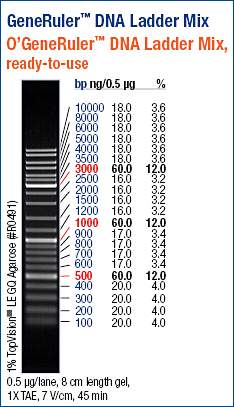Continuing with the RAD-seq library prep. Following the Meyer Lab 2bRAD protocol.
Prior to generating full-blown libraries, we need to run a “test-scale” PCR to identify the minimum number of cycles needed to produce the intended product size (166bp).
I ran PCR reactions on a subset (Sample #: 4, 7, 14, & 30) of the 10 samples that I performed adaptor ligations on earlier today.
All components were stored on ice.
dNTPs – 1mM working stock was made
- 10μL dNTPs (10mM)
- 90μL NanoPure H2O
ILL-LIB1 & 2 – 10μM working stocks were made
- 10μL ILL-LIB1 or -LIB2 (100μM)
- 90μL NanoPure H2O
ILL-HT1 & 2 – 1μM working stocks were made
- 1μL ILL-HT1 or -HT2 (100μM)
- 99μL NanoPure H2O
ILL-BC1 – 1μM working stock was made
- 1μL ILL-BC1 (100μM)
- 99μL NanoPure H2O
PCR reactions were set up on ice in 0.5mL PCR tubes.
| REAGENT | SINGLE REACTION (μL) | x4.4 |
| Template | 8 | NA |
| NanoPure H2O | 1 | 4.4 |
| dNTPs (1mM) | 4 | 17.6 |
| ILL-LIB1 (10μM) | 0.4 | 1.76 |
| ILL-LIB2 (10μM) | 0.4 | 1.76 |
| ILL-HT1 (1μM) | 1 | 4.4 |
| ILL-BC1 (1μM) | 1 | 4.4 |
| 5x Q5 Reaction Buffer | 4 | 17.6 |
| Q5 DNA Polymerase | 0.2 | 0.88 |
| TOTAL | 20 | 52.8 |
Combined 12μL of master mix with 8μL of the ligation reaction from earlier today.
Cycling was performed on a PTC-200 (MJ Research) with a heated lid:
| STEP | TEMP (C) | TIME (s) |
| Initial Denaturation |
|
|
| 27 cycles |
|
|
We’re following the “1/4 reduced representation” aspect of the protocol. As such, 5μL of each reaction was pulled immediately after the extension (72C – machine was paused) of cycles 12, 17, 22, & 27 in order to determine the ideal number of cycles to use. Also ran the ligation reactions (labelled “Digests” on the gel below) of two samples (samples #: 4 & 7) as a pre-PCR comparison.
These samples were run on a 1x modified TAE 2% agarose gel (w/EtBr).
Results:
The results aren’t great. No band(s) visible in any samples at even the highest cycle number (27 cycles). Although, if you squint pretty hard, an extremely faint band might be visible in between the 100/200bp markers in the 27 cycles group.
Regardless, the PCRs will need to be repeated with an increased number of cycles. This is not terribly surprising, as the Meyer Lab protocol indicates that degraded samples will likely need a greater number of cycles than what they recommend and that cycle number will have to be determined empirically.


One comment